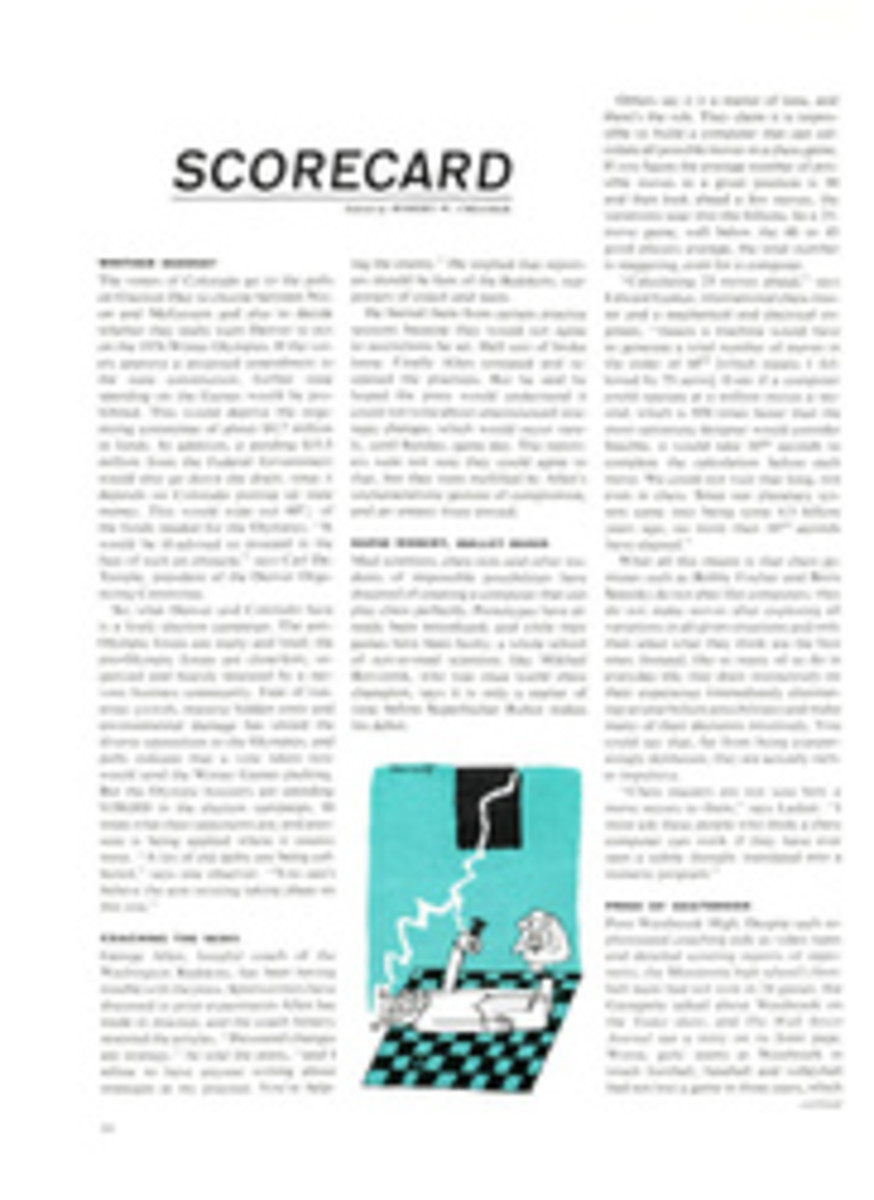
Maybe it will fit the bill
There are several easy ways to catch fish. One is with a net. Another is with a hand grenade. The hardest way is with a hook. Except for commercial longliners, hooks are largely the province of game fishermen, and they range in size from the bent pin the boy angler dangles at catfish and bullheads to the substantial barbs trolled on 130-pound-test line for giant billfish.
Hooks have caught some pretty big billfish, among them Alfred Glassell's 1,560-pound world-record black marlin and Cornelius Choy's 1,805-pound Pacific blue marlin (no record because Choy, a charter captain, set the hook for the three couples in his party and they took turns wrestling with the rod). Hooks also have missed a lot; it would be safe to say that for every billfish brought to the gaff or close enough to release, five shake free.
Is there a better way to fish for the marlin, the sail and the sword? Captain George Parker thinks so. A charter-boat skipper who first realized the potential of the now-famous blue marlin grounds off the Kona coast of Hawaii, Parker devised and is attempting to patent a "hookless lure" that he believes will not only revolutionize sports fishing but will make a considerable contribution to the scientific study of billfish migration.
Parker more or less disclosed his invention at the recent International Billfish Symposium in Hawaii. More or less is the operative phrase—he described the lure in general terms but refused to display it to the assembled sportsmen and scientists. Seldom has an unseen object provoked more furious debate.
The subject of lure variations had not been on the agenda, and Parker startled his listeners by introducing it. "Gentlemen, we don't have a very good mousetrap, do we?" he began. "Here at Kona we have six to nine strikes for every fish brought to gaff. But why do we use hooks? The billfish has hooks built right into its bill. Why not use a hookless lure that will be effective 90% of the time and will bring the fish to the boat harm-free?"
Parker then revealed that for the last four years he has experimented with a hookless lure of his own design. "We have taken more than 100 marlin on the lure," Parker said, "and have not lost a fish that struck it. The length of the fight is usually determined by the weight of the tackle—big fish can be taken on 80-, 50-, 30-, even 20-pound line. There is no blood in the water to attract sharks, and if the fish is released he has a much better chance of survival."
Elwood K. Harry, executive vice-president of the International Game Fish Association, immediately rose to attack the concept. "He's talking about an entangling device," Harry said. "There is nothing new in the idea. The whole question of the use of entangling devices came up eight or nine years ago. No angling skill is involved. Once a fish is entangled, he can't get loose. That isn't sport—it's commercialism."
Next, Dr. C. Richard Robins of the School of Marine and Atmospheric Science at the University of Miami suggested that it is the fight—and not the hook—that often kills released fish by creating unrepayable oxygen debt. "If the goal is to tag fish," Robins said, "a lure that would set the tag when the fish strikes and then break away would be desirable."
Parker was asked if he thought charter parties would accept the hookless lure, particularly if the fight were shortened and the fish released. "They have and they will," he said. "No one likes to pay $160 for a long boat ride and few strikes. Sometimes they won't even see the fish. Of course, they're not going to release all fish. Almost every fisherman wants a picture of himself with a big one hanging from the gantry. But I've found that most of my charters in the last few years have preferred releasing most of their fish.
"As for the IGFA," Parker continued, looking defiantly at Harry, "they are in business to protect old records made with fish taken on bamboo rods with cuttyhunk or linen lines. They have resisted every angling improvement—first nylon line, then monofilament, glass rods, the Hawaiian double-hook lure. Let's not give up a lure that gets the fish on the line. Angling is playing the fish, not setting the hook."
The session ended without further discussion of the lure, but the controversy bubbled on for days. Peter Goadby, a renowned game fisherman from Australia, was in vehement opposition. "There's no secret," Goadby said. "I could make one. You could make one. It's just the old wraparound—nylon threads flowing out behind an ordinary plastic lure. There's no sport in it. A bill-wrapped fish loses his leverage for the fight. He can't escape. Even if he's released, the ball of thread around his bill will kill his speed by creating drag. Besides that, it will drive him crazy. How would you like to go around with a big ball of twine around your nose?"
While no one can be sure that a ball of nylon around a marlin bill will annoy the fish as much as a ball of twine around a human nose, Goadby's view had a good deal of support, some of it from Parker's fellow charter skippers. "George says he invented the lure four years ago," protested one of them. "I've known about rag-mouth lures for the last 12 years. George is trying to make a dollar." Others criticized Parker for using the symposium to promote what they considered a private venture.
The reaction, however, was not entirely negative. A Kona fisherman who has seen and used the lure warmly endorsed Parker's claims. And Paul Caughlan, a member of the Port Hacking Game Fishing Club of Australia, approached Parker for details and was promised a sample lure when (and if) the patent is granted. Unlike his fellow Australian, Goadby, Caughlan had not heard of wraparound lures.
Neither had he until his invention, George Parker insisted. "I've been fishing with sportsmen from all over the world for the last 20 years," Parker said, "and none of them had ever heard of this kind of lure when I hit on it in 1968. I discovered the principle by accident. I had a fish on the deck and I was using a nylon rope. One end was frayed and when I tossed it down, it wrapped around the bill. I couldn't get it off and that night I couldn't sleep for thinking of it.
"I got up about 4 a.m. and made a crude prototype. I had a bill in the deepfreeze. I woke up my son and told him to hit the bill with the lure. He did—and together we couldn't get it loose. The next day I had a 71-year-old man who had fished with me for years as a charter. He agreed to try the hookless lure on one outrigger. He got a 150-pound marlin on 80-pound test. That was the beginning. Of course, the lure is very different now."
What Parker had discovered is that the rough, sandpapery surface of the bill grabs nylon thread the way a magnet holds iron filings. Parker says that his refined version does not create a large ball of thread around the bill; that the marlin does not lose its fighting abilities by this attachment of the line forward of mouth-hook locations; that even after a long fight on light tackle, the fish—un-scarred and unbloodied—has a far better chance to replenish its oxygen and survive than one attracting sharks with its own blood; that the lure can be modified to provide distant breakaways with plastic tags for purely tagging operations, or equipped with a transistorized transmitter for tracking if scientists so desire. Such tracking devices, until now, have been implanted in the fish's back with hooked darts.
Whether Parker's lure entails a patentable principle, and whether a commercial lure company will then produce it, are questions yet unanswered. Parker says he is negotiating with a West Coast tackle firm, but if an agreement is not reached he will manufacture the lure himself. Another question, one that concerns him less, is the lure's acceptability to the IGFA. There are no prohibitions in Hawaii against the use of such a device, and it seems certain that Parker charters will rely on it in the future. If, as Parker believes, use of the lure will triple charter catches, some of his dissenting fellow skippers will have little choice but to adopt it. At tournament time, of course, if the IGFA maintains its present position, it will be hooks again.
"I hate to think of all that blood out there," George Parker says, ecologically and perhaps economically.

